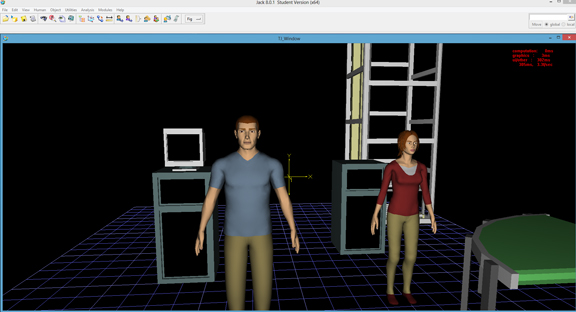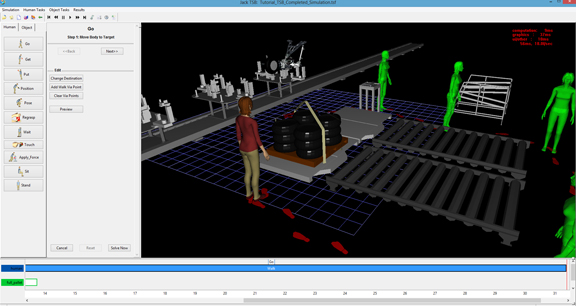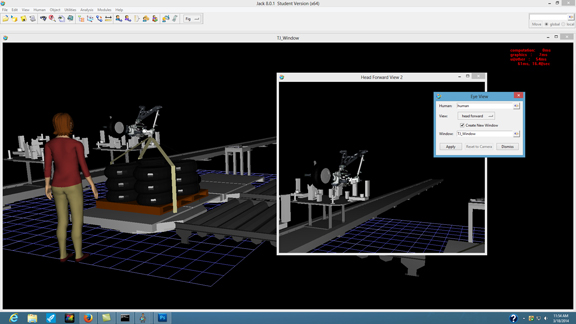Latest News
March 19, 2014
Jack and Jill—the two avatars from Siemens PLM’s Tecnomatix Jack software—are about to head into classrooms.
Jack and Jill are made of pixels, not flesh and blood, so you can subject them to extreme conditions, command them to lift unreasonable loads, or squeeze them into tight corners without guilt. They’re your guinea pigs to test plant floors, factory layouts, and assembly line configurations, among other things. Automotive and aerospace manufacturers use them routinely in the discipline known as process simulation. Last week, Siemens PLM released an academic license of Jack, available for free.
For the computer game generation, Tecnomatix Jack’s environment should look very familiar. (One of my young friends who saw me test-driving the software thought I was playing The SIMS.) The navigation commands in Jack are not instantly obvious, but once explained, they can easily be mastered. The key to it (quite literally it takes knowing the right key) is the following:
- Holding down CTRL lets you use your left, right, and middle mouse buttons for panning, rotating, and zooming in the 3D world;
- Left, right, and middle mouse buttons let you move objects side by side, up and down, and back and forth;
- Holding down SHIFT lets you use your left, right, and middle mouse buttons to rotate or orient objects.
Once the scene is populated, you can move into the Task Simulation Builder module to create a series of actions Jack or Jill would perform. No programming knowledge is needed, you’ll be relieved to know. You can use the software’s wizard to instruct your avatar to go to point A, fetch an object, then place it at point B. This allows you to simulate, for example, Jack walking up to the conveyor belt, picking up a tire, and mounting it on a mechanical arm at a distance. You may also instruct the virtual employee to apply pressure on a certain object, take a specific route to get to the destination, or wait in a designated spot. The factory objects are not solid by default, so quite often, Jack or Jill walk right through a conveyor belt or a cabinet. However, once you made an object solid, your virtual employees know to avoid them in their own path finding. In my view, the library objects should be solids by default to speed up the simulation setup.
Jack and Jill are fully rigged with joints, much like the animation characters in video game programs. For example, if you need to try out a position for his or her hands when carrying a monitor, you can drag the virtual figure’s hands to reposition them. When you do, you’ll notice the figure’s other body parts, like shoulders and neck, responding to the arm movements. It’s a good visual tool to test the virtual employee’s reach and comfort to operate certain levers or dials.
The software gives you the option to activate the avatar’s eye view, which lets you see the factory or plant surrounding from Jack or Jill’s eye level. As your avatar moves, the eye view changes accordingly. The feature is a useful tool to understand whether Jack or Jill might have dangerous machines lurking in his or her blind spot while performing the designated tasks.
The student version doesn’t offer the more robust functions like ergonomic analysis (seeing what a particular task does to Jack or Jill’s joints). It gives you a Time Report with some insights into the different stages of the task. The commercial version also offers human figures in different shapes to account for regional variations (for instance, the Asian population average is different from North American). In the student version, the two standard male and female figures can be cosmetically adjusted (customize their clothing colors, for instance).
Jack and Jill are by no means as well-textured and detailed as the game characters in today’s popular first-person shooters. (So don’t expect them to look like Lara Croft or Prince of Persia.) With the increase in graphics power in personal computers, perhaps future incarnations of Jack and Jill may take on new levels of realism. Nevertheless, for the video game generation, the software serves as an introduction to virtual process simulation in a familiar medium.
For more, watch my video report below:
Subscribe to our FREE magazine, FREE email newsletters or both!
Latest News
About the Author
Kenneth Wong is Digital Engineering’s resident blogger and senior editor. Email him at [email protected] or share your thoughts on this article at digitaleng.news/facebook.
Follow DE








